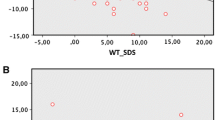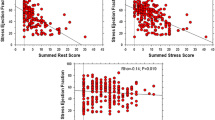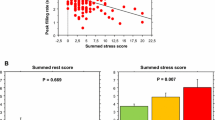Abstract
We investigated the causes and long-term prognosis of exercise-induced silent myocardial ischemia (SMI) by means of exercise Tl-201 myocardial SPECT (Ex-SPECT) in 97 patients with effort angina or old myocardial infarction (OMI). These patients were proven to have significant stenosis by coronary angiography. The subjects were divided into three groups based on the presence or absence of Tl-201 redistribution or angina during exercise testing. Group one consisted of 34 patients who had redistribution on Ex-SPECT and angina during exercise testing: the painful myocardial ischemia (PMI) group. The second group consisted of 38 patients who had redistribution on Ex-SPECT, but no angina during exercise testing: the SMI group. The third group consisted of 25 patients who had no redistribution: the RD (—) group.
The ischemic range and intensity were quantified by the defect volume ratio (DVR) and defect severity index (DSI), respectively. Comparison of the DVR and DSI values for the PMI and SMI groups revealed that the DVR and DSI values for the SMI group were lower than those of the PMI group. Also the prognosis of the SMI group tended to be worse than that of the RD (—) group. Thus, we concluded that the SMI and PMI group should receive identical treatment.
Similar content being viewed by others
References
Baker DG, Coleridge HM, Coleridge JCD, et al: Search for cardiac nociceptor stimulation by bradykinin of sympathetic afferent nerve endings in the heart of the cat.J Physiol (Lond.) 306: 519–536, 1980
Cohn PF, Kannel WB: Recognition, pathogenesis, and management options in silent coronary artery disease: introduction.Circulation 75 Suppl II: II-1, 1987
Garcia EV, Kenneth VT, Maddahi J, et al: Quantification of rotational Thallium-201 myocardial tomography.J Nucl Med 26: 17–26, 1985
Rozanski A, Berman DS: Silent myocardial ischemia: I. Pathophysiology, frequency of occurrence, and approaches toward detection.Am Heart J 114: 615–626, 1987
Katsuki T, Iino T, Hosoda S, et al: Evaluation of ischemic myocardium with regional time-activity curve of Tl-201.Kakuigaku 24: 1547–1555, 1987 (in Japanese)
Imai K, Araki Y, Nishio Y, et al: Studies on silent myocardial ischemia using thallium myocardial scintigraphy.Shinzo 22: 368–375, 1990 (in Japanese)
Heller GV, Garber CE, Connolly MJ, et al: Plasma beta-endorphin levels in silent myocardial ischemia induced by exercise.Am J Cardiol 59: 735–739, 1987
Sisson JC, Shapiro B, Meyers L, et al: Metaiodobenzylguanidine to map scintigraphically the adrenergic nervous system in man.J Nucl Med 28: 1625–1636, 1987
Nishimura T, Kurita T, Ohe T, et al: A case of myocardial infarction with ventricular tachycardia, which had discrepancy of defect size between123I-MIBG and201T1C1 myocardial imaging.Kakuigaku 26: 419–423, 1989 (in Japanese)
Gottlieb SO, Weisfeldt ML, Ouyang P, et al: Silent ischemia as a marker for early unfavorable outcomes in patients with unstable angina.N Engl J Med 314: 1214–1219, 1986
Fukami K, Haze K, Hiramori K, et al: Clinical and prognostic significance of silent myocardial ischemia in survivors after acute myocardial infarction.Jpn Circ J 53: 1407–1413, 1989
Cohn PF: Silent myocardial ischemia and infarction, Marcel Dekker Inc, 1986
Rozanski A, Berman DS: Silent myocardial ischemia: II. Prognosis and implications for the clinical assessment of patients with coronary artery disease.Am Heart J 114: 627–638, 1987
Author information
Authors and Affiliations
Rights and permissions
About this article
Cite this article
Moriai, N., Nakai, K. & Hiramori, K. The causes and clinical significance of exercise-induced silent myocardial ischemia evaluated by ischemic range and intensity with exercise Tl-201 myocardial SPECT. Ann Nucl Med 6, 29–35 (1992). https://doi.org/10.1007/BF03164639
Received:
Accepted:
Issue Date:
DOI: https://doi.org/10.1007/BF03164639




